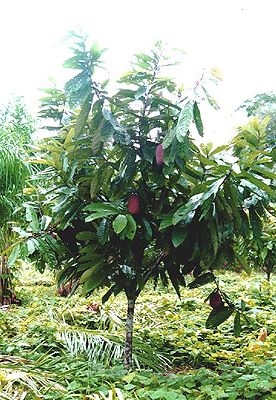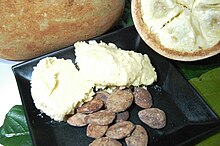Cupuaçu
| Cupuaçu | ||||||||||||
|---|---|---|---|---|---|---|---|---|---|---|---|---|

4 year old large-flowered cocoa ( Theobroma grandiflorum ) in a plantation near Manaus |
||||||||||||
| Systematics | ||||||||||||
|
||||||||||||
| Scientific name | ||||||||||||
| Theobroma grandiflorum | ||||||||||||
| ( Willd. Ex Spreng. ) Schum. |
Cupuaçu or Großblütiger cocoa ( Theobroma grandiflorum ) is a plant from the genus Theobroma within the family of the Malvaceae (Malvaceae). This little tree comes from Brazil . Its fruits can be used similarly to those of the related cocoa ( Theobroma cacao ); Compared to cocoa, however, cupuaçu has so far been of little commercial importance in Europe.
description
Vegetative characteristics
The large-flowered cocoa grows as a tree and reaches heights of up to 20 meters, with trunk diameters of up to 45 centimeters. Cultivated specimens are usually much smaller at around 6 to 10 meters. The trunk initially grows upright (orthotropic) about 1 to 1.5 meters and then divides into three side branches ( plagiotropic ). After a while, a bud sprouts again in the center of these three branches, grows vertically and forms a new "floor" with three side branches in this branching pattern. The vertical branches are promoted in the shade and the side branches in the sun. The root system consists of a weak taproot and otherwise remains close to the surface. The roots are not widely spread and hardly extend beyond the diameter of the tree canopy.
The simple, leathery, large and stalked leaves are 15 to 60 centimeters long and 7 to 15 centimeters wide and are obovate to elongated oval and have entire margins. When the leaves are sprouting, they are a little reddish in color and covered with brown hairs ( trichomes ), later they are green on the top and light green on the underside. There may be two small, hairy, persistent stipules .
Generative characteristics
The stalked flowers sit individually or in small groups together in zymous inflorescences on the side branches, but not on the vertical branches. The hermaphrodite flowers are radially symmetrical and five-fold. The three to five overgrown, thick, fleshy and ovate to ovoid, boat-shaped sepals are green-whitish and fine-haired on the outside. Five whitish and dome-shaped, fleshy petals with a spreading, reddish and spatula-shaped tongue follow inward . Five of the ten stamens are transformed into long, hairy, sterile, reddish and awlish, outwardly curved staminodes . The five short, fertile stamens each carry anthers with three two-chambered counters. Five carpels are an upper continuous, fine-haired fruit nodes with a short, yellow and conical stylus fused with expiring scar. The flowering time depends on the rainy seasons : the main flowering time is at the beginning of the rainy season , in October and November, a second, less frequent flowering period takes place from July to August.
The large, ellipsoidal berries (armored berries ) (or, according to another view, stone fruits ) ripen after four to five months and then reach a length between 12 and 35 centimeters, a diameter between 10 and 15 centimeters and a weight between half a and two and a half kilograms. Ripe fruits give off a strong, pleasant scent. The skin of the fruit, which is brown when ripe, is dense, short and hairy. The outer shell ( exocarp ) is hard and brittle, underneath is the thick, porous-fibrous and equally hard one ( mesocarp and endocarp ). There are 25 to 50 seeds in the fruit, which are covered by cream-colored, fragrant “pulp” ( pulp ). The brownish seeds are flattened and about 3 inches long and 2.5 inches wide. The seeds are only viable for a very short time. The germination takes place a few days after sowing hypogeous .
The number of chromosomes is 2n = 40.
distribution
Cupuaçu comes from the tropical lowland rainforests at altitudes below 400 meters on the lower Amazon , in the southeast of the Brazilian state of Pará and the adjacent Maranhão . The average temperatures are 24 to 28 ° C, the humidity is between 75 and 90%, the annual precipitation exceeds 1000 mm. The Cupuaçu plants grow there in the shade of taller trees and are very sensitive to dehydration. Brief floods are tolerated, but the soil must be permeable.
Due to human use, this plant species can be found in the entire Amazon basin and occasionally as far as Costa Rica.
The original habitat is greatly reduced by clearing forests and the construction of the Tucuruí dam .
use
The fruits are used: the “pulp” has a sour, aromatic taste and is mixed with sugar used in soft drinks, jams, liqueurs, vodka, yogurts, ice creams and similar products. Half of the seeds consist of fat and are used in a similar way to those of cocoa ( Theobroma cacao ). The chocolate produced is of poor quality, but this could be due to the inadequately developed fermentation techniques. Cupuaçu chocolate, also known as “cupulate” in Brazil, is of great importance in Amazonian cuisine. It can be used to make pralines, ice cream, creams, jellies and cakes.
Table of the use of cupuaçu
| Food as fruit | Cosmetics as butter | Remedies as a fruit |
| Desserts | Creams and lotions | Lowering blood pressure |
| Soft drinks | Hair care products | Diabetes prevention |
| jam | vegetable lanolin substitute | Cholesterol Reduction |
| yogurt | Alternative in case of intolerance to shea butter | Libido increase |
| Liqueurs as food | Anti-aging basis for vegan products | |
| chocolate | Lip care products | |
| Pralines as chocolate | Creams and lotions | |
| Jellies as fruit | Sunscreen | |
| Cakes as chocolate |
The fruit peel can be used as an organic fertilizer.
The seeds are used against abdominal pain and the cupuaçu juice, blessed by shamans, is said to have a relieving effect on difficult births. The Cupuacu butter is used for wound healing because of its antibacterial effect in the personal care it is appreciated for its high content of phytosterols, vitamin E , and because of its fragrance.
Three important varieties or groups of varieties are distinguished in culture:
- 'Mamau': seedless variety, is propagated via cuttings or grafting
- 'Mamorano' group: fruits pointed at the end, large
- 'Redondo' group: rounded, smaller fruits
Up to 7,000 fruits are harvested per hectare and year, which corresponds to around two tons of pulp and one and a half tons of seeds. The cultivation takes place in plantations, whereby mixed cultures bring good results, since the plants are adapted to partial shade. This is why large-flowered cocoa has a certain potential for near-natural management of Amazonian rainforest areas. Cupuaçu fruits sometimes come from wild collections on the market - a prospect for the inhabitants of the rainforest, as the sale of the fruits that are collected in a forest-friendly way provides them with a livelihood that does not involve slash and burn.
In 1985 the public research institute " EMBRAPA Amazônia Oriental" in Belém developed an improved process for the production of cupulates, the description of which was published in 1990. Nevertheless, a Japanese food company (Asahi Foods, Kyoto) tried to have Cupuaçu registered as a trademark in Japan, the USA and Europe and applied for patent protection for processing the oil-containing seeds into cupules. This provoked the protest of some NGOs who call this practice biopiracy . In the meantime, however, the trademark has been canceled and the patent applications have been rejected.
literature
- DC Giacometti: Cupuaçu (Theobroma grandiflorum). In: JE Hernándo Bermejo, J. León (Ed.): Neglected Crops - 1492 from a Different Perspective. Plant Production and Protection Series, Vol. 26, FAO, Rome 1994, pp. 205-209, ISBN 92-5-103217-3 .
- P. Schmidt, R. Lieberei, J. Bauch, L. Gasparotto: Tree species for the development of sustainable mixed culture systems in Central Amazonia. In: Communications of the German Dendrological Society. 91, Stuttgart 2006, pp. 167-171, ISSN 0070-3958 .
Web links
- New campaign in the fight against biopiracy on cupuaçu fruit. (PDF; 119 kB) - BUKO campaign against biopiracy 2005.
- Keyword: "Cupuaçu" patent application - information for the press. ( Memento of September 7, 2008 in the Internet Archive ) - European Patent Office 2003.
- Theobroma grandiflorum (Willd. Ex Spreng.) Schum., The cupuaçu-tree: additional use option and agro-ecology. - University of Hamburg, Biocenter Klein Flottbek and Botanical Garden.
Individual evidence
- ^ Reinhard Lieberei, Wolfgang Franke, Christoph Reisdorff: Nutzpflanzenkunde. 7th edition, Thieme, 2007, ISBN 978-3-13-530407-6 , p. 182.
- ↑ Maria Helena Martini, Camila Gonçalves Lenci, Antonio Figueira et al .: Localization of the cotyledon reserves of Theobroma grandiflorum (Willd. Ex Spreng.) K. Schum., T. subincanum Mart., T. bicolor Bonpl. and their analogies with T. cacao L. In: Rev. bras. Bot. Vol.31, No.1, São Paulo Jan./Mar. 2008, doi : 10.1590 / S0100-84042008000100013 .
- ^ Theobroma grandiflorum at Tropicos.org. In: IPCN Chromosome Reports . Missouri Botanical Garden, St. Louis.
- ↑ Cupuacu what is it and what is it used for? Retrieved May 27, 2020 (shopLocaleDrop).


